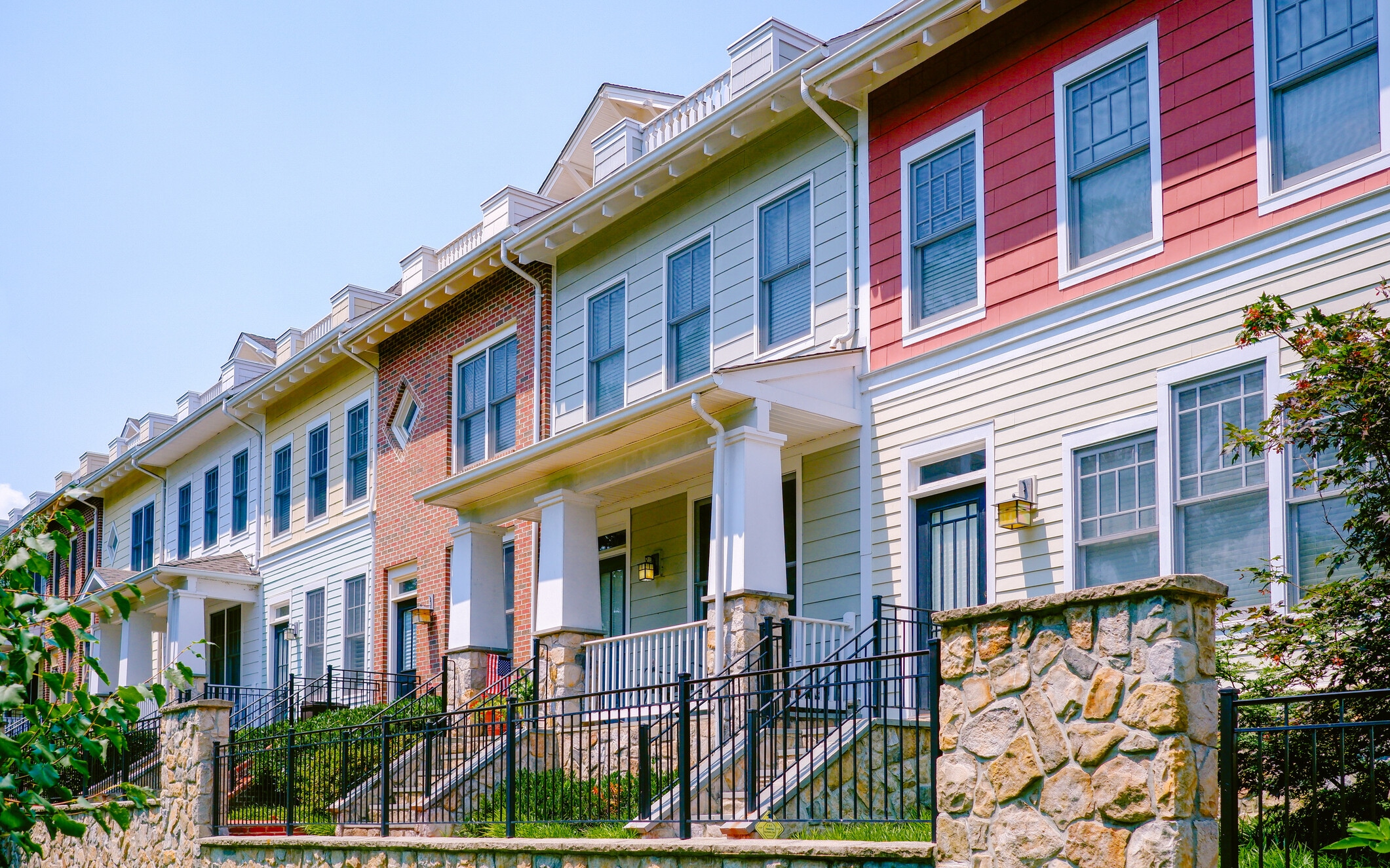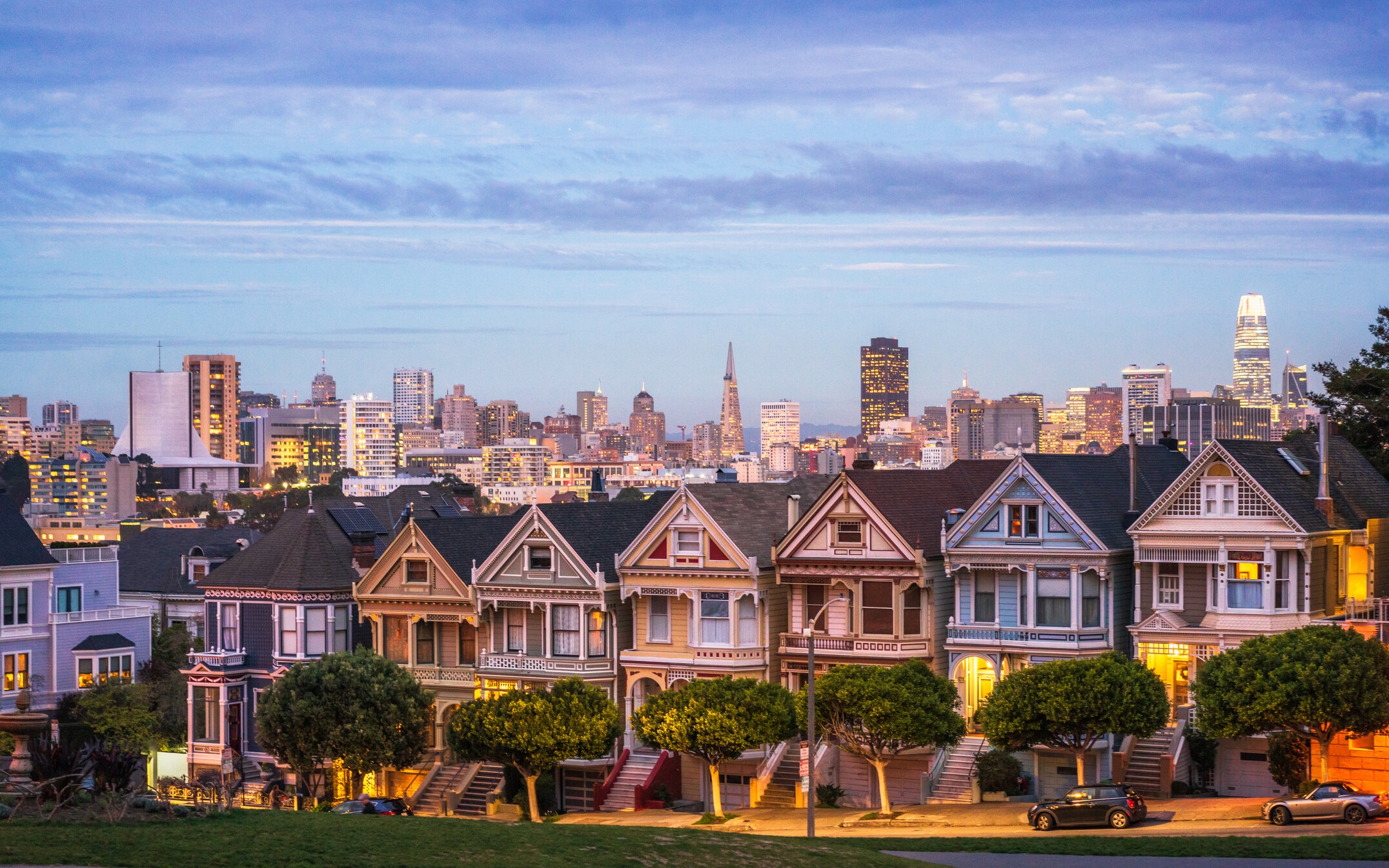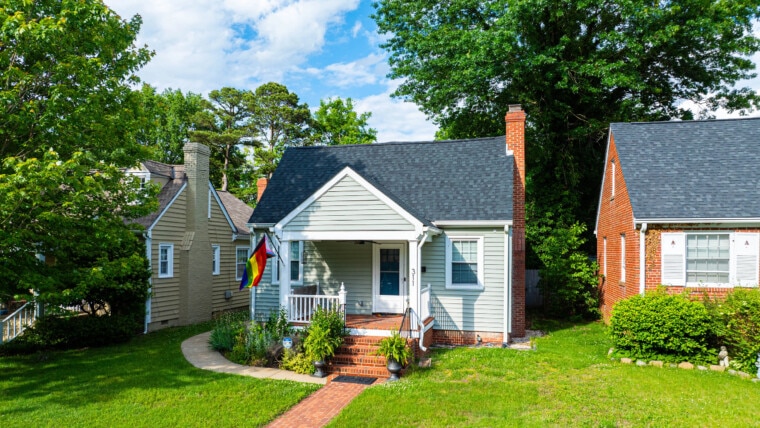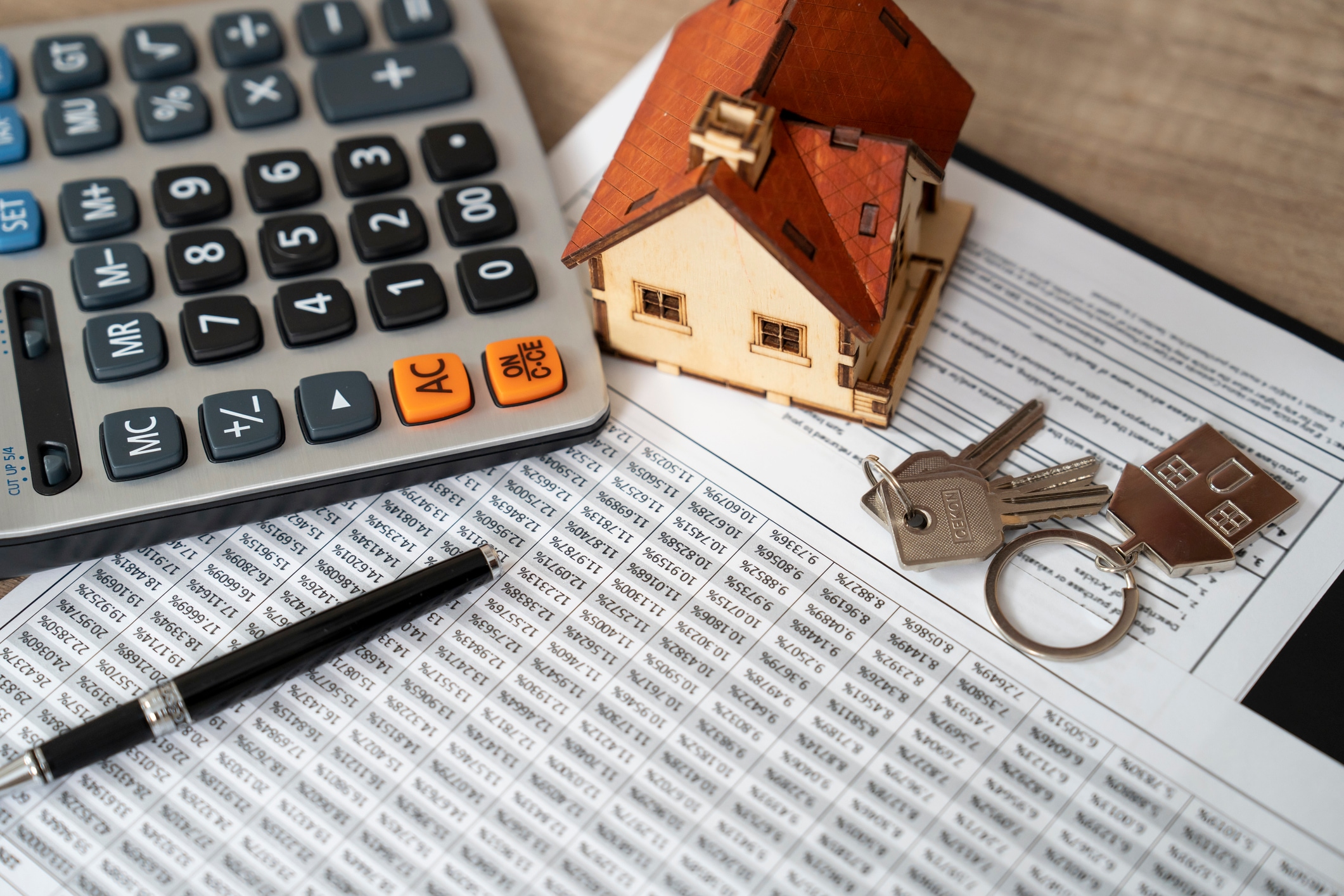When looking for a home, many of the listings that come up will be townhouses. They are typically tall, thin homes wedged between other houses of the same type. However, it’s not always clear what sets a townhome apart from apartments, condos and single-family houses. Townhomes are on the rise as a smaller and more affordable option for buyers. We’ll explore what makes this type of home unique and the pros and cons of owning a townhome.

What Is a Townhouse?
A townhouse is a home that typically has two or more floors and at least one shared wall with adjacent properties. That wall is sometimes called a party wall. They are recognizable as tall, narrow houses that are attached without any separation between them. They are typically located in suburban and urban areas, where they may be part of a townhouse development. They also frequently fall under homeowner’s associations.
Historical Background
Townhomes originated in Europe in the 1600s for the upper class, who needed homes in both the country and the city for convenience. At that time, “townhouse” had a loose meaning that could include any house in town, including large, detached estates. By the 1700s, the concept was understood as the shoulder-to-shoulder structures we see today. Townhomes spread to major U.S. cities like New York, NY, as well as Boston, MA, and Washington, D.C. With increasingly fewer square feet, it became a popular form of middle-class housing. Both then and now, these homes utilize the limited space in densely developed cities to provide much-needed housing. Often, they still offer excellent access to urban amenities.
Layout and Design Features
Today, townhomes exist in more than just cities. With their rise in popularity, townhomes are popping up in suburban developments. Regardless of location, they typically share some standard features. They might come in a row of two to 12 other townhomes. Entries are placed on the narrow side of the home, facing the street. In suburban areas, they may include attached garages. Inside, the living rooms are often on the bottom floor while bedrooms are on the upper floors. “If you like split living spaces, I think that’s a big pro,” says Amanda Oakley, a broker with Trueblood Real Estate. “Because the rooms are on different levels, that might add a bit of privacy.”
Differences Between a Townhouse and Other Property Types
It can be hard to differentiate a townhouse from other housing types. While townhomes share some fundamental similarities with other styles, they also have some key differences that set them apart.
Townhome vs. Apartment
Townhouses are buildings attached to other buildings, while apartments are housing units within one building. A significant difference between the two is ownership. Apartments are typically rented, while townhomes can be either rented or owned. In an apartment, landlords take care of general maintenance. Townhouse owners are responsible for general maintenance and upkeep, just like they would be with any other house. They must also adhere to HOA guidelines, if applicable. Both apartments and townhomes can have shared amenities like fitness centers and pools.
Townhouse vs. Condo
Both townhouses and condos offer ownership. A condo is a building divided into smaller units that are individually owned. Condos are essentially owned apartments. Condos and townhouses can differ in privacy level. Whereas townhouses only share up to two walls, condo owners may share walls next to, above and below other residents. As a result, condos sometimes offer less privacy than a townhouse. Both housing styles can have shared amenities and common areas.
Townhouse vs. Single-Family Home
A townhouse is a type of single-family home. Townhomes are attached, but like a standard single-family home, they include ownership of the land they’re built on and the interior and exterior of the building. Typical single-family homes are detached from other structures and offer more privacy. Unlike townhomes, single-family homes are also found in rural areas. Both townhomes and single-family homes can have front and back yards, but single-family homes can have significantly more private outdoor space. As long as zoning allows, you can also expand a single-family home with an addition such as a sunroom or in-law suite.

Pros and Cons of Living in a Townhouse
Townhomes offer affordability and convenience, making them an attractive option for many homebuyers. The pros of owning a townhouse include shared amenities and easier maintenance, but there are also some potential drawbacks.
Benefits of Living in a Townhouse
Townhouses stand above other styles for several reasons. According to a 2024 Washington Post report, townhouses are on the rise, following a trend of increasingly smaller new construction. Townhouses accounted for one in five newly built homes in 2023, which was a record high, the report says. Building smaller homes, including townhouses, helps the pocket of both builders and buyers. Here are some other big pros to owning a townhouse.
- Cost Considerations and Affordability: Townhouses may be less expensive than single-family homes. According to current Homes.com data, the median price for a townhouse in Indianapolis, IN, is $195,000, compared with $250,000 for a single-family home. In Tallahassee, FL, townhouses have a median price of $189,000, compared with $348,000 for a single-family home. Thanks to their smaller square footage, townhouses typically have lower heating and cooling bills.
- HOA fees can also factor into monthly costs. According to the U.S. Census Bureau’s 2021 American Housing Survey, the national average monthly HOA fee is $191. The older the community, the higher the maintenance fees might be because shared amenities can require replacement or extra TLC.
- Community and Shared Amenities: Shared amenities help to get your money’s worth out of your townhouse. HOA fees can often go toward these amenities for each resident to enjoy within the housing complex. Community centers can provide a space for private get-togethers. Some communities have a pool to help residents and guests beat the heat in the summer. Gyms may be scaled down but offer a convenient space to exercise before and after work. For some residents, having spaces to exercise, relax and get together is a big perk of townhouse ownership.
- Maintenance and Upkeep: Townhomes are generally easier to maintain than single-family homes. HOAs help relieve the burden of cleaning a pool, mowing grass, landscaping and other chores. Thanks to their smaller size, townhouses also require less upkeep on the owner’s part. If the HOA doesn’t cut the grass for you, lawns are generally small and don’t require as much care as single-family homes. With one or two walls attached to other units, there is also less exterior upkeep.
Potential Drawbacks of Townhouses
Townhouses also have some downsides that are worth considering before making a purchase. Here are some of the drawbacks to townhouse living.
- Limitations on Privacy: Privacy is one of the more significant considerations when it comes to living in a townhouse. Homebuyers should know they will share one or two walls with neighbors. “Whether you only share one wall, or you’re smack dab in between people on two different sides, that could have a pretty big impact,” says Amanda Oakley of Trueblood Real Estate. It could mean hearing your neighbors at all times of the day. That togetherness extends to outdoor spaces, too. Backyards sit close together and may not always have a fence to separate them.
- Homeowner Association (HOA) Rules and Fees: HOA rules and fees may be another drawback for townhouse owners. While not all townhouse communities fall under an HOA, most do. Many HOAs regulate noise levels, the ability to rent, holiday decorations, trash and pets. HOAs can also limit the extent of exterior renovations, additions and changes that townhouse owners can make. Sometimes, it’s a matter of reaching out to get approval for moderate or significant changes. On top of strict regulations, some homebuyers may find the mandatory fees to be burdensome in addition to other monthly bills. Additionally, homeowners could risk foreclosure if those dues are not paid.
- Townhouses are Multi-level Homes: Since most have a vertical layout, stairs are unavoidable. That could pose a challenge for people who may struggle to climb stairs or are at risk of falling. “I tell people, you have to remember every time you buy groceries, you’re going up the stairs,” Oakley says. A load of laundry may also require a trip up the stairs. Washers and dryers tend to be on the lower floors, away from the bedrooms.
Is a Townhouse Right for You?
A townhouse could be the right choice if you want a relatively affordable single-family home. Townhouses offer ownership opportunities and more space than an apartment or a condo. They might also be suitable if you are looking for a relatively low-maintenance home that doesn’t require mowing a large lawn. Townhouse living also provides an opportunity to develop a relationship with your neighbors.
A townhome might not be right for you if you want a detached single-family home or complete privacy from neighbors. They might also not be right for you if you prefer to have all bedrooms on the same floor, or if you want to avoid stairs. It’s also not a home that offers a lot of private land.
Day-to-day life in a townhouse can differ widely from other types of homes. Touring a townhouse with your real estate agent can provide insight into what that could look like. “I would tour it more than once, and tour it at different times of day so you can get to know the lifestyle,” Oakley says. Getting to know your prospective neighbors can also be helpful. “If someone works the night shift, they might be up all night,” she adds.
Considerations for Homebuyers and Investors
When considering buying a townhouse, it can be beneficial to consider the investment value. Generally, if a townhouse is in a desirable area, it will appreciate along with the other homes. A townhouse could be a good investment if you want a smaller and more affordable home.
Steps to Buying a Townhouse
The home-buying process for a townhouse is the same as the process for buying any other type of home. Once you’re ready to buy, here are some basic steps you can follow.
- Assess Your Finances
Before buying a townhouse, it’s essential to understand what you can afford. Generally, a good first step is to calculate your debt-to-income ratio and then get preapproved for a mortgage. That way, once you find a home, you can put in an offer quickly. There are other financial obligations, such as saving for the down payment and closing costs that are necessary to secure a home loan.
- Choose a Location
Where you live is as important as the house you buy. You’ll want to narrow down the state, city, and even neighborhood in which you’d like to live. On the Homes.com landing page, use the “Explore Great Neighborhoods” function to learn about the homes, schools, parks, shopping and dining, and other features of specific neighborhoods within a city. Those details can give you a better sense of what it’s like to live in an area.
- Start House Hunting
Once you’ve selected a location, it’s time to find the right townhouse. One way to start is by looking online. Homes.com search functions enable you to search for a townhouse by neighborhood, price range, number of bedrooms, and many other specifications. Listings will also mention if there is an open house coming up. A trusted real estate agent can be crucial for the house hunting process, helping guide you toward properties that best fit your needs.
- Make an Offer
The next step is to put in an offer. A real estate agent will help you craft a competitive offer that considers the market value, potential repairs needed, and the current market within the area. Buyers should act fast in a seller’s market when inventory is low and demand is high. This might require offering above the asking price. Your agent will help you put in a fair yet competitive bid.
- Finalize the Deal
If your offer was accepted, you’ve made it past a big hurdle. Once you’re under contract for a home, you must make an earnest money deposit, choose a mortgage, and have the home inspected and appraised.
- Close the Sale
After your due diligence, it’s time to close the deal. The final step is to sign the closing documents, including the title and deed to the house. The closing process includes paying closing costs like appraisal fees and attorney fees.
Common Questions About Townhouses
Townhouses are single-family homes that stand side-by-side with other townhouses. They typically share one or two walls with other townhouses without any separation between them. In most cases, a townhome has at least two floors.
Townhouses are recognizable as tall, narrow buildings that can sit in a row of two to 12 other units. Living rooms are typically on the bottom floor, while bedrooms are on the upper floors. They are usually found in either cities or suburbs and may be within a townhouse development. They often have HOAs and shared community features like pools and gyms.
In 17th-century Europe, the term “townhouse” originated to describe a house in a town. Today, “townhouse” represents a specific type of attached single-family house. Many townhouses still offer the convenience of living in city centers.
Liz Coughlin is an experienced journalist who spent three years as a reporter in the Villages, Florida, where she specialized in local news, human interest and entertainment stories. With a track record for quality hyper-local reporting, she loves to zoom in on neighborhoods across the country to uncover what makes each one special. Liz holds a B.A. in English with an emphasis on Editing, Writing and Media from Florida State University.











